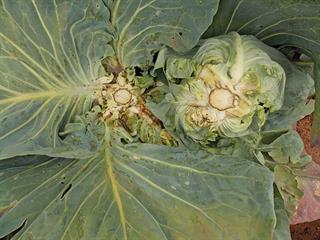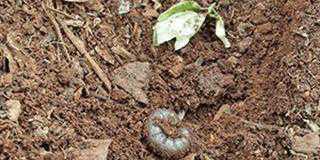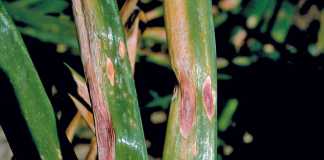
At the time of writing, there is uncertainty as to what pathogen causes the disease. Initially, it was declared to be a phytoplasma, a bacterium with a membrane instead of a cell wall, but subsequent tests have questioned this. Hopefully it will soon be identified so that control measures can be formulated. In the meantime, the disease has been named ‘brassica stunting disorder’ (BSD).
Another question that scientists are grappling with is how BSD entered South Africa. Although it is claimed not to be transmitted by seed, my own experience of BSD leads me to question this. I hope I’m proved wrong. After discussing this possibility, a seedling grower and I visited various farms and inspected the infected crops. One farmer was conducting a large trial of varieties from a European country.
Now, invariably, you find a few infected plants in a cluster, indicating that a vector has transmitted the pathogen to a plant. From there, the disease (or vector) spreads to adjoining plants. Alternately, the plant can be infected from the start and the disease can be spread to the other plants via a vector.
Strange infection patterns
By contrast, we discovered the following in the land we inspected:
- The trial area, comprising many thousands of plants, was unaffected;
- There were infected plants in the lands on either side of the trial area;
- Only single plants were infected here, and not clusters, as might be expected.
In my opinion, no vector could have accounted for this pattern. In an area occupied by a number of adjoining cabbage farmers, some had a 30% to 40% infection in one land but no infection at all in another land a few hundred metres away. If there is a vector, this suggests it does not travel far. Yet the outbreak occurred virtually simultaneously in areas far apart. (Some isolated growers produce their own seedlings as well.)
The first symptoms are a reddening of the leaves and/or stunting, which is especially severe if the plant is very young.
A mature infected plant may look normal apart from the colour, but if you cut through the stem you will find a ring of black tissue. This extends through the conducting tissue in the head. The head may be marketable but the customer is likely to complain once she has cut it open. The disease is more destructive in winter, with some areas being more affected than others.
Treatment
In the absence of more thorough knowledge on the subject, my advice to farmers is to go through their lands every two weeks and chop out each plant showing symptoms of BSD. This will reduce the amount of infected material. As leaf hoppers are currently the prime suspects as vectors, speak to your pest control rep about an insecticide to control this and other cabbage pests. When a badly infected land has been cut, it would probably help to spray a harsh chemical such as parathion, chlorophos or a pyrethroid. Next, work the residue into the soil to kill infected vectors still feeding on leaves left on the plants.
Removing weeds
It is also a good idea to apply herbicide to any weedy areas around the land. Until we know what the pathogen is and have more information on the disease, we cannot rule out the possibility of a weed species being a symptomless reservoir for the pathogen. Getting rid of weeds is any case good practice as they breed pests and diseases that affect other crops as well.













